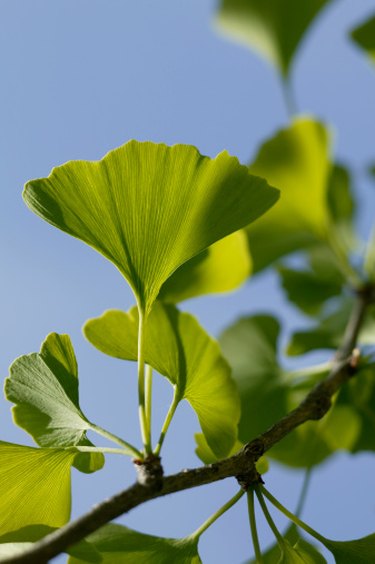
The ginkgo, or maidenhair tree, is one of the oldest trees on earth. This tree, known for its fan-shaped leaves, is a popular choice for city streets because it's tolerant to drought, salt, heat and pests. In addition, it's resistant to many diseases. However, no tree is totally immune to everything, and the ginkgo is no exception.
Botrytis
Video of the Day
Botrits, or gray mold is a fungal infection that attacks the young tissue of ginkgo trees. Symptoms include the appearance of a fuzzy gray mold on the leaves, flowers, buds or fruit. Small, black structures may also appear in the mold. Infected plant parts may release clouds of spores whenever they're disturbed. Before the mold appears, the leaves and flowers may turn brown, starting on the inner or middle petals. The fungus can't infect plants unless they're moist, and during humid weather, the symptoms can spread very quickly. Trees that are stressed or wounded are most susceptible.
Video of the Day
Botrytis Control
Although fungicides are available for treating botrytis, they aren't usually used. Instead, you should prune dead or dying leaves and flowers as soon as symptoms appear and either burn or bury diseased plant parts. If your ginkgo tree is being grown indoors, as a potted plant, improving ventilation may help symptoms. The fungus responsible for botrytis likes cool, wet weather. High temperatures will stop the spread of this disease.
Leaf Scorch
Leaf scorch is caused by a bacteria that causes gingko leaves to turn brown and fall off the tree. Although the tree may grow normal leaves the following year, the disease will reappear on new branches. Over a period of several year, all the leaves will eventually turn brown. In addition, twigs and branches die. Leaf scorch symptoms resemble other stress-related problems and the only way to know if your gingko tree has been infected is through a lab test. The leaf scorch bacteria is spread by leafhopper insects although, according to the University of Kentucky Extension website, the exact method by which it spreads isn't known. The bacteria damages trees by infecting the vascular tissue and blocking the ability of the tree to transport water and other nutrients to the leaves.
Leaf Scorch Control
Bacterial leaf scorch can't be cured, although it can take five or 10 years before your tree loses many branches. Prune dead wood to make the tree look more attractive. Provide infected trees with additional water when it's dry. Injecting trees with oxytetracyclene antibiotic can cause symptoms to temporarily disappear, but the medication has to be repeated at least once a year, and it isn't a cure. In addition, the wounds caused by injecting the tree may make it susceptible to organisms that cause wood rot.